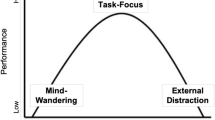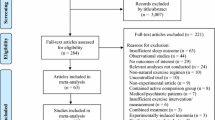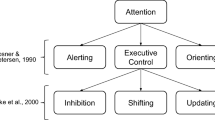Abstract
One outstanding question in the contemplative science literature relates to the direct impact of meditation experience on the monitoring of internal states and its respective correspondence with neural activity. In particular, to what extent does meditation influence the awareness, duration and frequency of the tendency of the mind to wander. To assess the relation between mind wandering and meditation, we tested 2 groups of meditators, one with a moderate level of experience (non-expert) and those who are well advanced in their practice (expert). We designed a novel paradigm using self-reports of internal mental states based on an experiential sampling probe paradigm presented during ~1 h of seated concentration meditation to gain insight into the dynamic measures of electroencephalography (EEG) during absorption in meditation as compared to reported mind wandering episodes. Our results show that expert meditation practitioners report a greater depth and frequency of sustained meditation, whereas non-expert practitioners report a greater depth and frequency of mind wandering episodes. This is one of the first direct behavioral indices of meditation expertise and its associated impact on the reduced frequency of mind wandering, with corresponding EEG activations showing increased frontal midline theta and somatosensory alpha rhythms during meditation as compared to mind wandering in expert practitioners. Frontal midline theta and somatosensory alpha rhythms are often observed during executive functioning, cognitive control and the active monitoring of sensory information. Our study thus provides additional new evidence to support the hypothesis that the maintenance of both internal and external orientations of attention may be maintained by similar neural mechanisms and that these mechanisms may be modulated by meditation training.




Similar content being viewed by others
References
Aftanas LI, Golocheikine SA (2001) Human anterior and frontal midline theta and lower alpha reflect emotionally positive state and internalized attention: high-resolution EEG investigation of meditation. Neurosci Lett 310(1):57–60
Baars BJ (2005) Global workspace theory of consciousness: toward a cognitive neuroscience of human experience. Prog Brain Res 150:45–53
Baird B, Smallwood J, Mrazek MD, Kam JW, Franklin MS, Schooler JW (2012) Inspired by distraction mind wandering facilitates creative incubation. Psychol Sci 0956797612446024
Baird B, Mrazek M, Phillips DT, Schooler JW (2014) Domain-specific enhancement of metacognitive ability following meditation training. J Exp Psychol Gen 143(5):1972–1979
Benjamini Y, Yekutieli D (2001) The control of the false discovery rate in multiple testing under dependency. Ann Stat 29:1165–1188
Berkovich-Ohana A, Harel M, Hahamy A, Arieli A, Malach R (2016) Data for default network reduced functional connectivity in meditators, negatively correlated with meditation expertise. Data Brief 8:910–914
Bollimunta A, Chen Y, Schroeder CE, Ding M (2009) Characterizing oscillatory cortical networks with Granger causality. In: Rubin J, Josic K, Matias M, Romo R (eds). Coherent behavior in neuronal networks. Springer, New York, pp 169–189
Bollimunta A, Mo J, Schroeder CE, Ding M (2011) Neuronal mechanisms and attentional modulation of corticothalamic alpha oscillations. J Neurosci 31:4935–4943
Braboszcz C, Delorme A (2011) Lost in thoughts: neural markers of low alertness during mind wandering. Neuroimage 54(4):3040–3047
Buckner RL, Andrews-Hanna JR, Schacter DL (2008) The brain’s default network. Ann NY Acad Sci 1124(1):1–38
Cahn BR, Polich J (2006) Meditation states and traits: EEG, ERP, and neuroimaging studies. Psychol Bull 132(2):180
Cavanagh J, Frank M (2014) Frontal theta as a mechanism for cognitive control. Trends Cogn Sci 18(8):414–421
Cavanagh JF, Shackman AJ (2015) Frontal midline theta reflects anxiety and cognitive control: meta-analytic evidence. J Physiol Paris 109(1):3–15
Christoff K, Gordon AM, Smallwood J, Smith R, Schooler JW (2009) Experience sampling during fMRI reveals default network and executive system contributions to mind wandering. Proc Natl Acad Sci 106(21):8719–8724
deBettencourt MT, Cohen JD, Lee RF, Norman KA, Turk-Browne NB (2015) Closed-loop training of attention with real-time brain imaging. Nat Neurosci 18(3):470–475
Delorme A, Makeig S (2004) EEGLAB: an open source toolbox for analysis of single-trial EEG dynamics including independent component analysis. J Neurosci Methods 134(1):9–21
Delorme A, Sejnowski T, Makeig S (2007) Enhanced detection of artifacts in EEG data using higher-order statistics and independent component analysis. Neuroimage 34(4):1443–1449
Desbordes G, Gard T, Hoge EA, Hölzel BK, Kerr C, Lazar SW, Olendzki A, Vago DR (2015) Moving beyond mindfulness: defining equanimity as an outcome measure in meditation and contemplative research. Mindfulness 6(2):356–372
Enriquez-Geppert S, Huster RJ, Scharfenort R, Mokom ZN, Zimmermann J, Herrmann CS (2014) Modulation of frontal-midline theta by neurofeedback. Biol Psychol 95:59–69
Garrison KA, Zeffiro TA, Scheinost D, Constable RT, Brewer JA (2015) Meditation leads to reduced default mode network activity beyond an active task. Cogn Affect Behav Neurosci 15(3):712–720
Gusnard DA, Raichle ME (2001) Searching for a baseline: functional imaging and the resting human brain. Nat Rev Neurosci 2(10):685–694
Haegens S, Osipova D, Oostenveld R, Jensen O (2010) Somatosensory working memory performance in humans depends on both engagement and disengagement of regions in a distributed network. Hum Brain Mapp 31(1):26–35
Hasenkamp W, Barsalou LW (2012) Effects of meditation experience on functional connectivity of distributed brain networks. Front Hum Neurosci 6:38
Hirsh JB, Inzlicht M (2010) Error-related negativity predicts academic performance. Psychophysiology 47(1):192–196
Hölzel BK, Lazar SW, Gard T, Schuman-Olivier Z, Vago DR, Ott U (2011) How does mindfulness meditation work? Proposing mechanisms of action from a conceptual and neural perspective. Perspect Psychol Sci 6(6):537–559
James W (1890) The principles of psychology. Holt, New York
Jang JH, Jung WH, Kang DH, Byun MS, Kwon SJ, Choi CH, Kwon JS (2011) Increased default mode network connectivity associated with meditation. Neurosci Lett 487(3):358–362
Kaser M, Soltesz F, Lawrence P, Miller S, Dodds C, Croft R et al (2013) Oscillatory underpinnings of mismatch negativity and their relationship with cognitive function in patients with schizophrenia. PLoS ONE 8(12):e83255
Kerr CE, Jones SR, Wan Q, Pritchett DL, Wasserman RH, Wexler A et al (2011) Effects of mindfulness meditation training on anticipatory alpha modulation in primary somatosensory cortex. Brain Res Bull 85(3):96–103
Kerr CE, Sacchet MD, Lazar SW, Moore CI, Jones SR (2013) Mindfulness starts with the body: somatosensory attention and top-down modulation of cortical alpha rhythms in mindfulness meditation. Front Hum Neurosci 7:12
Killingsworth MA, Gilbert DT (2010) A wandering mind is an unhappy mind. Science 330(6006):932
Maris E, Oostenveld R (2007) Nonparametric statistical testing of EEG-and MEG-data. J Neurosci Methods 164(1):177–190
Mazaheri A, Fassbender C, Coffey-Corina S, Hartanto TA, Schweitzer JB, Mangun GR (2014) Differential oscillatory electroencephalogram between attention-deficit/hyperactivity disorder subtypes and typically developing adolescents. Biol Psychiatry 76(5):422–429
Morecraft RJ, Tanji J (2009) Cingulofrontal interactions and the cingulate motor areas. In: Vogt BA (ed) Cingulate neurobiology and disease. Oxford University Press, Oxford, pp 113–144
Mrazek MD, Smallwood J, Schooler JW (2012) Mindfulness & mind-wandering: finding convergence through opposing constructs. Emotion. doi:10.1037/a0026678
Mrazek MD, Franklin MS, Phillips DT, Baird B, Schooler JW (2013) Mindfulness training improves working memory capacity & GRE performance while reducing mind wandering. Psychol Sci 24(5):776–781
Poerio G, Totterdell P, Miles E (2013) Mind wandering and negative mood: does one thing really lead to another? Conscious Cogn 22(4):1412–1421
Raichle ME (2015) The brain’s default mode network. Annu Rev Neurosci 38:433–447
Schooler JW, Smallwood J, Christoff K, Handy TC, Reichle ED, Sayette MA (2011) Meta-awareness, perceptual decoupling and the wandering mind. Trends Cogn Sci 15(7):319–326
Segal ZV, Teasdale JD, Williams JMG (2004) Mindfulness-based cognitive therapy: theoretical rationale and empirical status. In: Hayes SC, Follette VM, Linehan M (eds) Mindfulness and acceptance: expanding the cognitive-behavioral tradition. Guilford Press, New York, NY, pp 45–65
Slagter HA, Lutz A, Greischar LL, Francis AD, Nieuwenhuis S, Davis JM, Davidson RJ (2007) Mental training affects distribution of limited brain resources. PLoS Biol 5(6):e138
Smallwood J, Schooler JW (2006) The restless mind. Psychol Bull 132(6):946
Smallwood J, Baracaia S, Lowe M, Obonsawin M (2003) Task unrelated thought whilst encoding information. Conscious Cogn 12(3):452–484
Smallwood J, Fishman DJ, Schooler JW (2007) Counting the cost of an absent mind: mind wandering as an underrecognized influence on educational performance. Psychon Bull Rev 14(2):230–236
Spreng RN (2012) The fallacy of a “task-negative” network. Front Psychol 3:145
Spreng RN, Sepulcre J, Turner GR, Stevens WD, Schacter DL (2013) Intrinsic architecture underlying the relations among the default, dorsal attention, and frontoparietal control networks of the human brain. J Cogn Neurosci 25(1):74–86
Swick D, Turken U (2002) Dissociation between conflict detection and error monitoring in the human anterior cingulate cortex. Proc Natl Acad Sci 99(25):6354–16359
Sze JA, Gyurak A, Yuan JW, Levenson RW (2010) Coherence between emotional experience and physiology: does body awareness training have an impact? Emotion 10:803–814
Tang YY, Hölzel BK, Posner MI (2015) The neuroscience of mindfulness meditation. Nat Rev Neurosci 16(4):213–225
Teper R, Inzlicht M (2013) Meditation, mindfulness and executive control: the importance of emotional acceptance and brain-based performance monitoring. Soc Cogn Affect Neurosci 8(1):85–92
Welch PD (1967) The use of fast Fourier transform for the estimation of power spectra: a method based on time averaging over short, modified periodograms. IEEE Trans Audio Electroacoust 15(2):70–73
Whitmarsh S, Barendregt H, Schoffelen JM, Jensen O (2014) Metacognitive awareness of covert somatosensory attention corresponds to contralateral alpha power. Neuroimage 85:803–809
Yordanova J, Kolev V, Rothenberger A (2013) Event-related oscillations reflect functional asymmetry in children with attention deficit/hyperactivity disorder. Clin Neurophysiol 62:289–301
Zanesco AP, King BG, MacLean KA, Jacobs TL, Aichele SR, Wallace BA, Saron CD (2016) Meditation training influences mind wandering and mindless reading. Psychol Conscious Theory Res Pract 3(1):12
Acknowledgements
This work was supported by Grants from the ANR (Agence Nationale pour la Recherche) ANR-12-JSH2-0009 and the BIAL foundation BIAL-08-162. The authors wish to thank the late Swami Veda, Gopalkrishna Prabhu, Pravin Kumar Soni, John Sellinger and all the members of the Swami Rama Sadhaka Grama ashram where the data were collected and the volunteers who participated in this study.
Author information
Authors and Affiliations
Corresponding author
Rights and permissions
About this article
Cite this article
Brandmeyer, T., Delorme, A. Reduced mind wandering in experienced meditators and associated EEG correlates. Exp Brain Res 236, 2519–2528 (2018). https://doi.org/10.1007/s00221-016-4811-5
Received:
Accepted:
Published:
Issue Date:
DOI: https://doi.org/10.1007/s00221-016-4811-5




